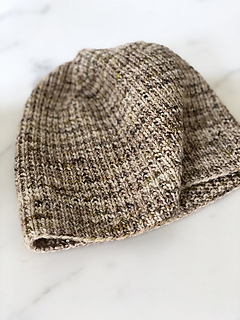patterns >  Jaclyn Salem's Ravelry Store
Jaclyn Salem's Ravelry Store
> Olmsted Hat






Olmsted Hat
Olmsted is a basic, every-day wear hat pattern. It’s knit in broken rib stitch at a DK-weight gauge, making it incredibly versatile for many yarns. (My favorite way to knit this hat recipe is to use those precious fingering-weight skeins of sock yarn held double.) Because rib is very elastic, this hat stretches to fit most adult heads, making it an excellent choice for gift knits.
It is named after Frederick Law Olmsted, an American landscape architect who designed many parks including New York City’s Central Park and Prospect Park. Olmsted is popularly considered to be the father of American landscape architecture! “He paints with lakes and wooded slopes; with lawns and banks and forest-covered hills; with mountainsides and ocean views.” His work, especially in Central Park in New York City, set a standard of excellence that continues to influence landscape architecture in the United States. He was an early and important activist in the conservation movement, including work at Niagara Falls, the Adirondack region of upstate New York, and the National Park system.
This is by far my most worn hat pattern, and I’ve knit it several times for gifts over the years. I hope you enjoy it!
Yarn
• 1 skein of fingering weight sock yarn (held double) OR 1 skein of DK weight yarn.
Needles
• U.S. 4 (3.5mm) 16” in circular needle
• U.S. 4 (3.5mm) DPNs for crown decreases
Gauge
24 stitches = 4 inches in broken rib stitch OR 6 sts= 1 inch in broken rib knit in the round
Sizing and Fit
This hat has been fit-tested on many different adult head sizes (male, female, adults, teens, smaller heads and larger heads!). Because rib is so stretchy, this hat is an excellent project to ensure good fit for many people—making it perfect for gift knitting!
Notions
• 1 stitch marker
• Tapestry needle
Techniques Used
• knitting and purling
• decreasing (k3tog and p3tog)

339 projects
stashed
321 times
1170 projects
stashed
919 times
- First published: September 2019
- Page created: September 10, 2019
- Last updated: September 30, 2019 …
- visits in the last 24 hours
- visitors right now




